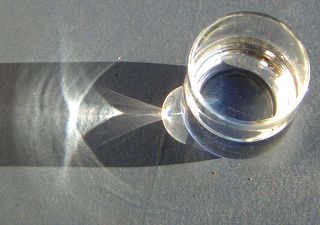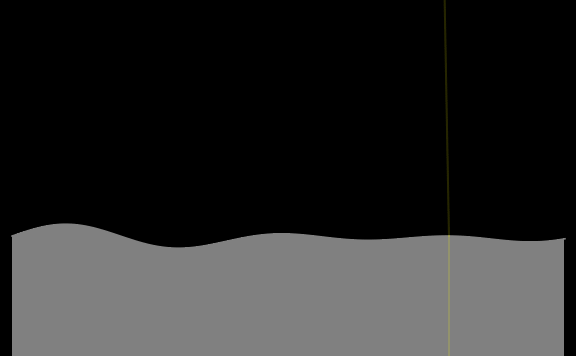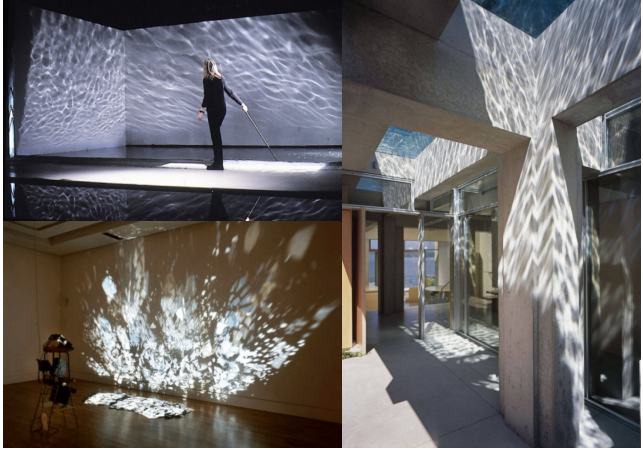Caustic (optics) on:
[Wikipedia]
[Google]
[Amazon]
 In
In
 Concentration of light, especially
Concentration of light, especially
here
The focus of most computer graphics systems is aesthetics rather than physical accuracy. This is especially true when it comes to real-time graphics in computer games where generic pre-calculated textures are mostly used instead of physically correct calculations.
 Once the caustic pattern has been designed computationally, the processed data will be then sent to the manufacturing stage to get the final product. The most common approach is subtractive manufacturing (
Once the caustic pattern has been designed computationally, the processed data will be then sent to the manufacturing stage to get the final product. The most common approach is subtractive manufacturing ( Caustic pattern design has many real-world applications, for example in:
* Luminaires
* Jewelry
* Architecture
* Decorative glass production
Caustic pattern design has many real-world applications, for example in:
* Luminaires
* Jewelry
* Architecture
* Decorative glass production
 In
In optics
Optics is the branch of physics that studies the behaviour and properties of light, including its interactions with matter and the construction of optical instruments, instruments that use or Photodetector, detect it. Optics usually describes t ...
, a caustic or caustic network is the envelope
An envelope is a common packaging item, usually made of thin, flat material. It is designed to contain a flat object, such as a letter (message), letter or Greeting card, card.
Traditional envelopes are made from sheets of paper cut to one o ...
of light rays which have been reflected
Reflection is the change in direction of a wavefront at an interface between two different media so that the wavefront returns into the medium from which it originated. Common examples include the reflection of light, sound and water waves. The ...
or refracted by a curved surface or object, or the projection
Projection or projections may refer to:
Physics
* Projection (physics), the action/process of light, heat, or sound reflecting from a surface to another in a different direction
* The display of images by a projector
Optics, graphics, and carto ...
of that envelope of rays on another surface. The caustic is a curve
In mathematics, a curve (also called a curved line in older texts) is an object similar to a line, but that does not have to be straight.
Intuitively, a curve may be thought of as the trace left by a moving point. This is the definition that ...
or surface
A surface, as the term is most generally used, is the outermost or uppermost layer of a physical object or space. It is the portion or region of the object that can first be perceived by an observer using the senses of sight and touch, and is ...
to which each of the light rays is tangent
In geometry, the tangent line (or simply tangent) to a plane curve at a given point is, intuitively, the straight line that "just touches" the curve at that point. Leibniz defined it as the line through a pair of infinitely close points o ...
, defining a boundary of an envelope of rays as a curve of concentrated light. In some cases caustics can be seen as patches of light or their bright edges, shapes which often have cusp singularities.
Explanation
 Concentration of light, especially
Concentration of light, especially sunlight
Sunlight is the portion of the electromagnetic radiation which is emitted by the Sun (i.e. solar radiation) and received by the Earth, in particular the visible spectrum, visible light perceptible to the human eye as well as invisible infrare ...
, can burn. The word ''caustic'', in fact, comes from the Greek καυστός, burnt, via the Latin ''causticus'', burning.
A common situation where caustics are visible is when light shines on a drinking glass. The glass casts a shadow, but also produces a curved region of bright light. In ideal circumstances (including perfectly parallel rays, as if from a point source at infinity), a nephroid-shaped patch of light can be produced. Rippling caustics are commonly formed when light shines through waves on a body of water.
Another familiar caustic is the rainbow
A rainbow is an optical phenomenon caused by refraction, internal reflection and dispersion of light in water droplets resulting in a continuous spectrum of light appearing in the sky. The rainbow takes the form of a multicoloured circular ...
. Scattering of light by raindrops causes different wavelength
In physics and mathematics, wavelength or spatial period of a wave or periodic function is the distance over which the wave's shape repeats.
In other words, it is the distance between consecutive corresponding points of the same ''phase (waves ...
s of light to be refracted into arcs of differing radius, producing the bow.
Computer graphics
In computer graphics, most modern rendering systems support caustics. Some of them even support volumetric caustics. This is accomplished by raytracing the possible paths of a light beam, accounting for the refraction and reflection. Photon mapping is one implementation of this. Volumetric caustics can also be achieved by volumetric path tracing. Some computer graphic systems work by "forward ray tracing" wherein photons are modeled as coming from a light source and bouncing around the environment according to rules. Caustics are formed in the regions where sufficient photons strike a surface causing it to be brighter than the average area in the scene. “Backward ray tracing” works in the reverse manner beginning at the surface and determining if there is a direct path to the light source. Some examples of 3D ray-traced caustics can be founhere
The focus of most computer graphics systems is aesthetics rather than physical accuracy. This is especially true when it comes to real-time graphics in computer games where generic pre-calculated textures are mostly used instead of physically correct calculations.
Caustic engineering
Caustic engineering describes the process of solving theinverse problem
An inverse problem in science is the process of calculating from a set of observations the causal factors that produced them: for example, calculating an image in X-ray computed tomography, sound source reconstruction, source reconstruction in ac ...
to computer graphics
Computer graphics deals with generating images and art with the aid of computers. Computer graphics is a core technology in digital photography, film, video games, digital art, cell phone and computer displays, and many specialized applications. ...
. That is, given a specific image, to determine a surface whose refracted or reflected light forms this image.
In the discrete version of this problem, the surface is divided into several micro-surfaces which are assumed smooth, i.e. the light reflected/refracted by each micro-surface forms a Gaussian caustic. Gaussian caustic means that each micro-surface obey Gaussian distribution
In probability theory and statistics, a normal distribution or Gaussian distribution is a type of continuous probability distribution for a real number, real-valued random variable. The general form of its probability density function is
f(x ...
. The position and orientation of each of the micro-surfaces are then obtained using a combination of Poisson integration and simulated annealing
Simulated annealing (SA) is a probabilistic technique for approximating the global optimum of a given function. Specifically, it is a metaheuristic to approximate global optimization in a large search space for an optimization problem. ...
.
There have been many different approaches to address the continuous problem. One approach uses an idea from transportation theory called '' optimal transport'' to find a mapping between incoming light rays and the target surface. After obtaining such a mapping, the surface is optimized by adapting it iteratively using Snell's law
Snell's law (also known as the Snell–Descartes law, the ibn-Sahl law, and the law of refraction) is a formula used to describe the relationship between the angles of incidence and refraction, when referring to light or other waves passing th ...
of refraction.
Optimal-transport-based caustic pattern design
Basic principle
Controlling caustic pattern is rather a challenging problem as very minor changes of the surface will significantly affect the quality of the pattern since light ray directions might be interfered by other light rays as they intersect with and refract through the material. This will lead to a scattered, discontinuous pattern. To tackle this problem, optimal-transport-based is one of the existing proposed methods to control caustic pattern by redirecting light's directions as it propagates through the surface of a certain transparent material. This is done by solving an inverse optimization problem based on optimal transport. Given a reference image of an object/pattern, the target is to formulate the mathematical description of the material surface through which light refracts and converges to the similar pattern of the reference image. This is done by rearranging/recomputing the initial light intensity until the minimum of the optimization problem is reached.Manufacturing
 Once the caustic pattern has been designed computationally, the processed data will be then sent to the manufacturing stage to get the final product. The most common approach is subtractive manufacturing (
Once the caustic pattern has been designed computationally, the processed data will be then sent to the manufacturing stage to get the final product. The most common approach is subtractive manufacturing (machining
Machining is a manufacturing process where a desired shape or part is created using the controlled removal of material, most often metal, from a larger piece of raw material by cutting. Machining is a form of subtractive manufacturing, which util ...
).
Various materials can be used depending on the desired quality, the effort it takes to manufacture, and the available manufacturing method.
* Common refractive materials: acrylic, polycarbonate
Polycarbonates (PC) are a group of thermoplastic polymers containing carbonate ester, carbonate groups in their chemical structures. Polycarbonates used in engineering are strong, toughness, tough materials, and some grades are optically transp ...
, polyethylene
Polyethylene or polythene (abbreviated PE; IUPAC name polyethene or poly(methylene)) is the most commonly produced plastic. It is a polymer, primarily used for packaging (plastic bags, plastic films, geomembranes and containers including bott ...
, glass
Glass is an amorphous (non-crystalline solid, non-crystalline) solid. Because it is often transparency and translucency, transparent and chemically inert, glass has found widespread practical, technological, and decorative use in window pane ...
, diamond
Diamond is a Allotropes of carbon, solid form of the element carbon with its atoms arranged in a crystal structure called diamond cubic. Diamond is tasteless, odourless, strong, brittle solid, colourless in pure form, a poor conductor of e ...
* Common reflective materials: steel
Steel is an alloy of iron and carbon that demonstrates improved mechanical properties compared to the pure form of iron. Due to steel's high Young's modulus, elastic modulus, Yield (engineering), yield strength, Fracture, fracture strength a ...
, iron
Iron is a chemical element; it has symbol Fe () and atomic number 26. It is a metal that belongs to the first transition series and group 8 of the periodic table. It is, by mass, the most common element on Earth, forming much of Earth's o ...
, aluminum
Aluminium (or aluminum in North American English) is a chemical element; it has chemical symbol, symbol Al and atomic number 13. It has a density lower than that of other common metals, about one-third that of steel. Aluminium has ...
, gold
Gold is a chemical element; it has chemical symbol Au (from Latin ) and atomic number 79. In its pure form, it is a brightness, bright, slightly orange-yellow, dense, soft, malleable, and ductile metal. Chemically, gold is a transition metal ...
, silver
Silver is a chemical element; it has Symbol (chemistry), symbol Ag () and atomic number 47. A soft, whitish-gray, lustrous transition metal, it exhibits the highest electrical conductivity, thermal conductivity, and reflectivity of any metal. ...
, titanium
Titanium is a chemical element; it has symbol Ti and atomic number 22. Found in nature only as an oxide, it can be reduced to produce a lustrous transition metal with a silver color, low density, and high strength, resistant to corrosion in ...
, nickel
Nickel is a chemical element; it has symbol Ni and atomic number 28. It is a silvery-white lustrous metal with a slight golden tinge. Nickel is a hard and ductile transition metal. Pure nickel is chemically reactive, but large pieces are slo ...
 Caustic pattern design has many real-world applications, for example in:
* Luminaires
* Jewelry
* Architecture
* Decorative glass production
Caustic pattern design has many real-world applications, for example in:
* Luminaires
* Jewelry
* Architecture
* Decorative glass production
See also
*Focus (optics)
In geometrical optics, a focus, also called an image point, is a point where ray (optics), light rays originating from a point on the object vergence (optics), converge. Although the focus is conceptually a point, physically the focus has a s ...
* Circle of confusion
* Caustic (mathematics)
References
Further reading
* * {{DEFAULTSORT:Caustic (Optics) Geometrical optics